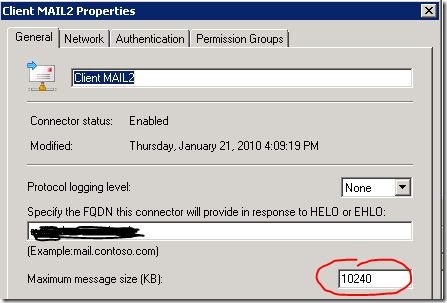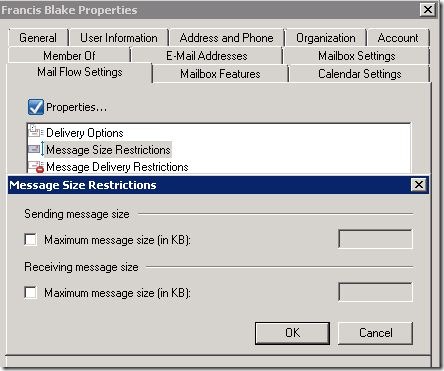source: http://eightwone.com/2010/09/29/exchange-message-size-limits/
![Exchange-2010-Logo-733341[1]](http://eightwone.files.wordpress.com/2009/11/exchange-2010-logo-7333411.png?w=150&h=71)
While
traveling trough your Exchange organization or beyond, e-mail messages
may be imposed to all sorts of limitations. One of these limits is the
message size limit, which can be set on the following levels:
- Organizational Level
- Send Connector
- Receive Connector
- AD Site Links
- Routing Group Connectors
- Individual
The path evaluated is as follows: User Send Limit > Receive
Connector > Organization Checks > Send Connector > User Receive
Limit
In general, the lowest size limit on an e-mail route determines if a
message can be successfully transported from sender to the recipient.
Exception is the individual setting which can override the other
settings for internal messages. Strategy is to define limits where
appropriate and as soon as possible. It’s a waste of resources to accept
a message, send it throughout the organization via several hops, to
finally reject the message because the recipient has a maximum receive
size limit.
Organizational Level
The message size limits on the organization level can be set through the Exchange Management Console via
Organization Configuration > Hub Transport > Global Settings by opening the
Properties of Transport Settings:

Of course, you can also view the settings using the Exchange Management Shell using Get-TransportConfig, e.g.

As you can see, the default value in Exchange 2010 is 10240 (10 MB)
for both receive as well as send message sizes. If you require a higher
value, for example to enable people to send and receive larger
attachments, you can use the EMC or Set-TransportConfig:
Set-TransportConfig –MaxReceiveSize 25MB –MaxSendSize 25MB
As you might expect, MaxReceiveSize applies to receive connectors,
MaxSendSize applies to send connectors. Valid range for this setting is
anywhere in the range between 64KB and 2GB or Unlimited. When set to
Unlimited
(which once was the default values in Exchange 2007 RTM), no limit will
be imposed. I don’t recommend using Unlimited since it can lead to
service disruption caused by processing large messages.
Send Connector
The message size limits on a send connector can be set through the Exchange Management Console via
Organization Configuration > Hub Transport > Send Connectors by opening the
Properties of the Send Connector:

You can also use Get-SendConnector to view the setting:

The default maximum sending message size for Exchange 2007/2010 send
connectors is 10 MB. If you want to be able to send larger messages over
this send connector, you can use the EMC or Set-SendConnector:
Set-SendConnector –Identity Internet –MaxMessageSize 25MB
Valid range for this setting is anywhere in the range between 64KB and 2GB or Unlimited.
Receive Connector
The message size limits on a send connector can be set through the Exchange Management Console via
Server Configuration > Hub Transport by opening the
Properties of the Receive Connector in the Receive Connectors pane:

You can also use Get-ReceiveConnector:

The default maximum receiving message size for receiving messages for
Exchange 2007/2010 receive connectors is 10 MB. If you want to be able
to receive larger messages over this receive connector, you can use the
EMC or Set-ReceiveConnector:
Set-ReceiveConnector –Identity “MAIL1\Default MAIL1” –MaxMessageSize 25MB
Valid range for this setting is anywhere in the range between 64KB and 2GB or Unlimited.
AD Site Link
Messages travelling between Hub Transport servers are subject
to AD site link limits. By default site links have no message size
limit. You can view AD site link settings using Get-AdSiteLink or use
Set-AdSiteLink to configure MaximumMessageSize when required.

Note that Hub Transport servers use least cost routing to route
messages. When a message exceeds a site link limit, the message will not
be delivered. Hub Transport servers will not try to deliver the message
using a different route.
Routing Group Connectors
In a co-existence scenario you might have routing group connectors
connecting Exchange 2007/2010 to an Exchange 2003 environment. Routing
group connectors have no maximum message size limit by default.
To inspect a routing group connector maximum message size settings, use Get-RoutingGroupConnector:
Get-RoutingGroupConnector <ConnectorID> | FL Name, *Max*
To configure a maximum message size limit on a RGC use Set-RoutingGroupConnector:
Set-RoutingGroupConnector <ConnectorID> -MaxMessageSize 25Mb
Individual
You can create exceptions for the MaxReceiveSize and
MaxSendSize values for mailbox users, mail-enabled contacts and
distribution groups. By default no limits are imposed (i.e. Unlimited).
To inspect the settings for a mailbox user, navigate to
Recipient Configuration > Mailbox and open the
Properties of the User. Activate tab
Mail Flow Settings and open the
Properties of the
Message Size Restrictions settings:

or use the related cmdlet, e.g. Set-Mailbox UserID –MaxSendSize 1GB –MaxReceiveSize 1GB:

If you set an individual maximum send or receive size setting higher
than the organization or connector limits, the individual setting will
override those limits when the message is send internally, e.g the
recipient resides in the same organization. This way you can create
exceptions for certain individuals which require a higher message size
limit.
source: http://eightwone.com/2010/09/29/exchange-message-size-limits/




![Exchange-2010-Logo-733341[1]](http://eightwone.files.wordpress.com/2009/11/exchange-2010-logo-7333411.png?w=150&h=71)









